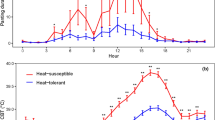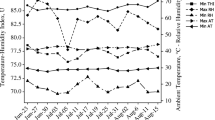Abstract
Three Zebu and three Highland mature heifers were used to study the effect of a moderately high environmental temperature (31°C) on temperatureregulatory responses of cold- and heat-tolerant cattle to thermal stress. Following a 7-day period of adjustment to 31°C, the Highland heifers decreased their internal heat production by decreasing feed consumption by 31% and oxygen consumption by 19%. They also increased their evaporative heat losses by an increased respiration rate of 92% and total vaporization (33%). At 31°C, water consumption increased 190% and body fluid compartments showed a significant increase, with the exception of plasma volume. The Zebu decreased feed consumption by 19%, increased respiration rate 100%, total vaporization 80%, water consumption 58%, and plasma volume by 17%. The Highland cattle could not prevent hyperthermia upon exposure to the moderate high temperature, while the Zebus maintained normal rectal temperature. Breed differences in ability to maintain homeothermy are documented in this study.
Similar content being viewed by others
References
GREGERSON, M. J., GIBSON, J. G., and STEAD, E. A. (1935): Plasma volume determination with dyes: error in calorimetry; use of blue dye-T-1824. Amer. J. Physiol., 113: 54–55.
KAMAL, T. H. and SEIF, S. M. (1969): Effect of natural and controlled climates of the Sahara on virtual tritium space in Friesians and Water Buffaloes. J. Dairy Sci., 52: 1657–1663.
KIBLER, H. H. (1960): Oxygen consumption in cattle in relation to rate of increase in environmental temperature. Nature (Lond.), 186: 972–973.
MACFARLANE, W. V., and HOWARD, B. (1966): Water content and turnover of identical twinBos indicus andBos taurus in Kenya. J. Agr. Sci., 66: 297–302.
PANDEY, M. D. and ROY, A. (1969): Variation in cardiorespiratory rates, rectal temperature, blood haematocrit and haemoglobin as measures of adaptability in buffaloes to a hot environment. Brit. Vet. J., 125: 463–471.
SEIF, S. M., JOHNSON, H. D. and HAHN, L. (1973): Environmental heat and partial water restriction effects of body fluid spaces, water loss, body temperature and metabolism of Holstein cows. J. Dairy Sci., 56: 581–586.
TAYLOR, C. R. (1968): The minimum water requirements of some East African bovids. Symp. Zool. Soc. Lond., 21: 195–206.
THOMPSON, H. J., WORSTELL, D. M., and BRODY, S. (1951): XV. Influence of environmental temperature, 0° to 105° F., on hair and skin temperatures and on partition of heat dissipation between evaporative and non-evaporative cooling in Jersey and Holstein cattle. Mo. Agr. Exp. Sta. Res. Bull. 481:18P.
Author information
Authors and Affiliations
Additional information
Contribution from the Missouri Agriculture Experiment Station. Journal Series No.
Rights and permissions
About this article
Cite this article
Seif, S.M., Johnson, H.D. & Lippincott, A.C. The effects of heat exposure (31°C) on Zebu and Scottish Highland cattle. Int J Biometeorol 23, 9–14 (1979). https://doi.org/10.1007/BF01553372
Received:
Issue Date:
DOI: https://doi.org/10.1007/BF01553372




